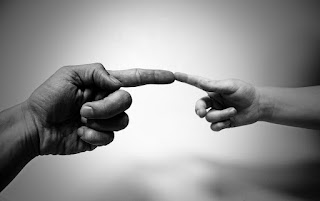Learned Helplessness: Has It Got You Trapped?
Have you ever wondered how those majestic beasts, the circus elephants, are convinced to perform in the circus for our entertainment? I mean after all, they are GIANT beasts and could easily take down the tent and everyone in it. How exactly does the trainer control them?
The analogy of the circus elephant is an elegant teaching tool used by Bobbi L. Parish M.A. in her video "What is Learned Helplessness?" And I'd like to use it here to help you understand exactly what learned helplessness is and how it works. Understanding it can help us approach victims of abuse with more compassion and caring. It may even help us find compassion for ourselves.
So the trainer attaches a steel shackle to her foot and chains her to a stake in the ground. At first she pulls and struggles to get away, frightened, but she quickly discovers that she cannot escape because she is not strong enough to pull the stake out of the ground. She quickly accepts this as her new reality - her world is comprised of the limitations imposed by that length of chain. She no longer struggles or fights to get free. She accepts that there is no escape from the whip if she doesn't obey the trainer.
As time passes, she grows and grows. Larger steel shackles and chains replace the small ones she started with. She grows huge and powerful, but still she remains confined by the shackle. Eventually, the shackle and chain are removed entirely. They aren't needed any longer - she has accepted her fate. The trainer can easily keep her in line with just the whip. We all recognize that now, full grown, she could crush the trainer and his whip and run away. Why doesn't she do so?
The answer is learned helplessness.
When she was small, the trainer was essentially her parent. And he confined her and taught her the rules of her world. He showed her she was helpless. And she accepted the reality of that helplessness as her life-long fate. And even though reality changed, her belief in her helplessness and the rules her trainer taught her when she was a baby are branded into her psyche and she is no longer able to see any alternative reality. The circus tent IS her reality.
The child who grows up witnessing her mother being beaten by her father, quickly learns she is incapable of stopping the violence. She becomes overwhelmed with terrible feelings of shame and helplessness. She learns that the impotent blows of her small fists against her father's legs do nothing to stop the beatings, and worse, result in being punished herself.
Or consider the child who is sexually abused by a family friend. At first she struggles against the abuse, but is quickly overpowered physically and is unable to rescue herself. Soon physical restraint is no longer required. The perpetrator uses threats and terror tactics to convince the child to remain silent and to acquiesce to the abuse - he threatens to kill her kitten or to harm her family if she tells. He may even kill her kitten in front of her to demonstrate his power. She quickly learns to see the perpetrator as all-powerful, and so she acquiesces. In her child's world, he IS all-powerful. She will continue to acquiesce long after it becomes apparent to everyone that she can easily escape him, and need not fear his threats.
The analogy of the circus elephant is an elegant teaching tool used by Bobbi L. Parish M.A. in her video "What is Learned Helplessness?" And I'd like to use it here to help you understand exactly what learned helplessness is and how it works. Understanding it can help us approach victims of abuse with more compassion and caring. It may even help us find compassion for ourselves.
The Analogy of the Circus Elephant
The trainer starts training the elephant when he or she is a baby. In this analogy, I'll use "she". She is little and not able to do much, taken away from her mother at a young age, she is small and helpless and doesn't understand the world.So the trainer attaches a steel shackle to her foot and chains her to a stake in the ground. At first she pulls and struggles to get away, frightened, but she quickly discovers that she cannot escape because she is not strong enough to pull the stake out of the ground. She quickly accepts this as her new reality - her world is comprised of the limitations imposed by that length of chain. She no longer struggles or fights to get free. She accepts that there is no escape from the whip if she doesn't obey the trainer.
As time passes, she grows and grows. Larger steel shackles and chains replace the small ones she started with. She grows huge and powerful, but still she remains confined by the shackle. Eventually, the shackle and chain are removed entirely. They aren't needed any longer - she has accepted her fate. The trainer can easily keep her in line with just the whip. We all recognize that now, full grown, she could crush the trainer and his whip and run away. Why doesn't she do so?
The answer is learned helplessness.
When she was small, the trainer was essentially her parent. And he confined her and taught her the rules of her world. He showed her she was helpless. And she accepted the reality of that helplessness as her life-long fate. And even though reality changed, her belief in her helplessness and the rules her trainer taught her when she was a baby are branded into her psyche and she is no longer able to see any alternative reality. The circus tent IS her reality.
The Helpless Child
Now think of the helplessness of a child. The child's world is constructed of whatever limitations the adult imposes upon them.The child who grows up witnessing her mother being beaten by her father, quickly learns she is incapable of stopping the violence. She becomes overwhelmed with terrible feelings of shame and helplessness. She learns that the impotent blows of her small fists against her father's legs do nothing to stop the beatings, and worse, result in being punished herself.
Or consider the child who is sexually abused by a family friend. At first she struggles against the abuse, but is quickly overpowered physically and is unable to rescue herself. Soon physical restraint is no longer required. The perpetrator uses threats and terror tactics to convince the child to remain silent and to acquiesce to the abuse - he threatens to kill her kitten or to harm her family if she tells. He may even kill her kitten in front of her to demonstrate his power. She quickly learns to see the perpetrator as all-powerful, and so she acquiesces. In her child's world, he IS all-powerful. She will continue to acquiesce long after it becomes apparent to everyone that she can easily escape him, and need not fear his threats.
The Helpless Adult
Once the child is an adult, how does learned helplessness play out? Here are some examples of what it can look like:- That friend that becomes quickly and easily overwhelmed by everyday "calamities" like car trouble, and completely falls apart descending into tears, catastrophizing and panic
- The young woman who passively accepts the beatings her boyfriend metes out and loses herself in dizzying circles of faulty logic to justify continuing to accept the abuse.
- The man who can't seem to draw any boundaries with his verbally abusive, demanding mother, and who is always doing her bidding no matter how unreasonable her demands.
- The young woman who continues an incestuous relationship with her father well into adulthood.
- That co-worker who passively accepts his boss' abusive brow-beating and berating, and may even justify it with self-criticism.
Learned helplessness is the collateral damage of childhood abuse. It is life-limiting and life-altering and a devil to overcome. Treating a client held hostage by learned helplessness requires a LOT of patience, compassion and creativity. Judgment and condemnation will completely shut down the therapeutic process. It's a try 20-times/fail-19 kind of process.
But that one success can start a victim of learned helplessness down a life-changing path. You can rise from the ashes of learned helplessness, and discover a whole new world of possibilities for yourself. Don't give up hope, beloved. You can THRIVE! Reach out to a trauma recovery coach or trauma-informed therapist to help you start the process.
Stephanie Shipp
Follow THRIVE on Facebook and Instagram:
https://www.instagram.com/thrivetraumarecoverycoaching/
Recommended: What is Learned Helplessness?
https://www.youtube.com/watch?v=Yau8-PL5baI&t=76s
Recommended: What is Learned Helplessness?
https://www.youtube.com/watch?v=Yau8-PL5baI&t=76s




Comments
Post a Comment